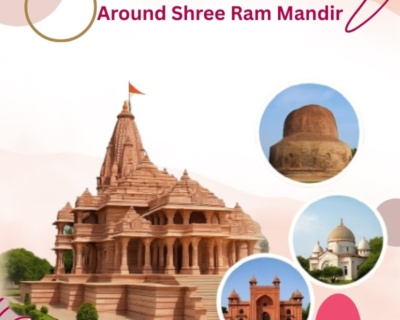Ram Mandir Architecture & Design: A Spiritual Masterpiece
- May 25, 2025
- Uncategorized
The city of Ayodhya, long considered the birthplace of Lord Ram, has always been a spiritual landmark. But with the recent construction of the Ram Mandir, this ancient city has stepped into the global spotlight. While the temple holds deep religious significance for millions of devotees, what makes it truly remarkable is its awe-inspiring architecture a blend of ancient tradition, spiritual symbolism, and modern engineering.
The Ram Mandir is not just a place of worship. It is a masterpiece in every sense a structure that speaks volumes about India’s rich heritage and timeless devotion. In this article, we explore the architectural beauty and thoughtful design behind this sacred temple that’s capturing hearts around the world.
A Temple Born of Devotion and Determination
The Ram Mandir isn’t an ordinary building. Its roots go deep into Indian history, culture, and faith. For centuries, people believed in the sacred spot in Ayodhya as the birthplace of Lord Ram. After decades of legal and social struggles, the dream of constructing a grand temple finally came true.
The architecture was entrusted to the Sompura family, renowned temple architects whose ancestors have been designing temples for over 15 generations. Led by Chandrakant Sompura and his sons, the team created a design that draws inspiration from ancient texts and temple architecture styles, especially the Nagara style.
Embracing the Nagara Style
The Ram Mandir is built in the Nagara style of temple architecture, which is typical of northern India. If you’ve seen temples in Khajuraho or Konark, you’ll notice similar spires and intricate carvings.
Here’s what makes the Nagara style stand out in the Ram Mandir:
Shikharas (Spires): The tallest spire rises 161 feet above the sanctum and symbolizes reaching towards the divine.
Mandapas (Halls): There are five grand halls used for prayer, music, and gatherings each richly carved and spiritually meaningful.
Elevated Platform: The temple stands on a high plinth, emphasizing its sacred nature.
Sanctum Sanctorum (Garbhagriha): Positioned in such a way that sunlight gently illuminates the idol of Ram Lalla, especially at specific times of the day.
The beauty of the Nagara style lies in how it combines vertical elevation with ornate detailing making the structure feel both grounded and divine.
Built to Last for Centuries
One of the most impressive things about the Ram Mandir is the materials used in its construction. Everything has been chosen with longevity and tradition in mind.
Key construction materials:
Bansi Paharpur Pink Sandstone: Brought from Rajasthan, this tough, reddish-pink stone gives the temple a warm and majestic appearance.
Makrana Marble: Used in the sanctum, this pure white marble (also used in the Taj Mahal) adds an ethereal feel.
No Steel or Concrete: In line with ancient building methods, the temple uses interlocking stones and copper joints avoiding steel or iron completely.
The builders aimed to create a structure that could withstand the test of time possibly standing tall for the next thousand years.
Grand Dimensions and a Thoughtful Layout
The Ram Mandir is massive, but every inch has been carefully planned to reflect spiritual meaning and architectural balance.
At a glance:
Length: 360 feet
Width: 235 feet
Height: 161 feet
Levels: 3 floors
Pillars: Over 360 intricately carved columns
Mandapas: Five large halls for religious and cultural functions
The main entrance, called Singh Dwar, leads into a beautifully designed path that opens up into the sanctum. The entire layout follows Vastu Shastra, ensuring spiritual energy flows naturally throughout the structure.
Symbolism Carved in Stone
What sets the Ram Mandir apart is how deeply it is infused with symbolism. Every pillar, carving, and hall tells a story rooted in the Ramayana or Indian philosophy.
Garbhagriha: The sanctum represents the innermost chamber of the heart, where God resides. It’s peaceful, pure, and sacred.
Mandapas: Each hall represents different aspects of devotion from music (Kirtan Mandap) to prayer (Prarthana Mandap).
Shikharas: The rising towers represent spiritual ascent our journey from the earthly to the divine.
Carvings: Scenes from the life of Lord Ram, including Hanuman’s devotion, Sita’s grace, and the victory over evil, are etched on walls and pillars.
It’s not just a temple it’s a visual form of the Ramayana, carved in stone.
Marrying Ancient Wisdom with Modern Engineering
Though traditional in design, the Ram Mandir is built with the help of cutting-edge engineering to ensure its safety and strength.
Earthquake-Resistant: The temple’s foundation includes multiple layers of reinforced concrete, engineered to handle seismic activity.
No Metal Framework: Instead of using modern steel, builders used a technique called interlocking stone construction, as seen in ancient Indian temples.
Eco-Friendly Drainage: Special systems ensure the temple stays dry and damage-free even during heavy monsoons.
Technology Integration: Modern surveillance, energy efficient lighting, and crowd management systems have been incorporated discreetly.
This blend of old and new makes the Ram Mandir both authentic and future-ready.
More Than Just a Temple: A Spiritual Campus
The Ram Mandir isn’t a standalone shrine. The entire area has been developed into a spiritual and cultural complex, designed to accommodate lakhs of devotees while preserving the temple’s serenity.
Key features include:
Yatri Niwas: Comfortable accommodations for thousands of pilgrims.
Museum & Digital Gallery: Showcasing artifacts, stories, and ancient manuscripts related to Lord Ram and the Ramayana.
Meditation and Satsang Halls: Spaces for collective prayer, learning, and reflection.
24-foot wide Parikrama Path: Allows devotees to walk around the temple in reverence.
Gardens and Pathways: Designed to create a calming, green environment for visitors.
The goal is to offer a complete spiritual experience, not just a quick darshan.
A Global Symbol of Unity and Faith
What makes the Ram Mandir even more special is the collective emotion behind it. People from every corner of India and the world contributed through donations, voluntary service, and sending soil and water from sacred rivers.
This temple has become a symbol of unity, devotion, and India’s spiritual identity. Its design reflects not just architectural brilliance, but the love and faith of millions who waited generations to see this dream realized.
Final Thoughts
The Ram Mandir in Ayodhya is not just an architectural landmark it’s a living symbol of devotion, a work of art, and a marvel of engineering. From its spiritually aligned layout to the hand-carved sandstone pillars, every detail has been crafted with purpose, precision, and prayer.
Whether you’re an architecture enthusiast, a spiritual seeker, or simply someone who appreciates beauty and history, visiting this temple will leave you with a deep sense of wonder and peace.








